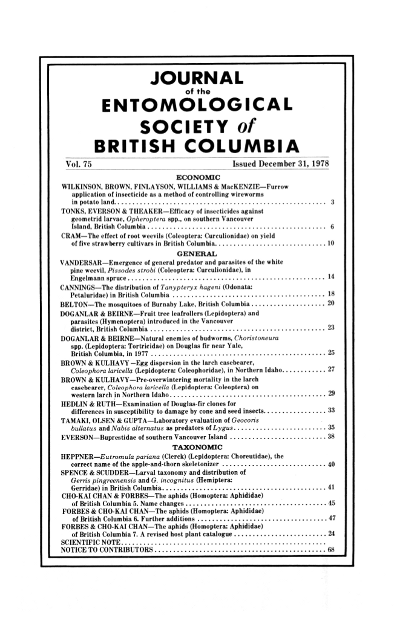The effect of root weevils (Coleoptera: Curculionidae) on yield of five strawberry cultivars in British Columbia
Keywords:
root weevils, Coleoptera, Curculionidae, strawberryAbstract
To determine the effect of root weevils on strawberry yield, 5 strawberry cultivars: Totem, Shuksan, Northwest, Cheam and BC-25 were infested in the field with 2 or 8 adults per plant of 1 of 4 species of root weevils: the black vine weevil, <i>Otiorhynchus sulcatus</i> (F.); the strawberry root weevil, <i>O. ovatus</i> L.; the obscure strawberry root weevil, <i>Sciopithes obscurus</i> Horn; and the woods weevil <i>Nemocestes incomptus</i> (Horn). There were no significant differences in yield between weevil infestations in the first cropping season. In the second year plants in the plot infested with 8 <i>O. sulcatus</i> per plant produced significantly less fruit than those in all other infestations. Within this plot Totem and Cheam produced significantly more fruit than the other cultivars. In the third year most of the other weevil-infested plots produced significantly less fruit than the uninfested plot. The plot with 2 <i>N. incomptus</i> per plant was the most severely damaged in the third season. The cultivars Totem and Cheam were usually the most tolerant to all weevils. Northwest and BC-25 were the most susceptible to all weevils. The tolerance of Totem to attack by the main root weevil species, <i>O. sulcatus</i>, is probably related to the ability of the plant to produce and regenerate a large supply of roots.
References
Cram, W.T. and C.L. Neilson. 1975. Recognition and life history of the major insect and mite pests of berry crops in British Columbia. B.C. Dept. of Agric. publ'n.
Downloads
Published
Issue
Section
License
Authors who publish with the Journal of the Entomological Society of British Columbia agree to the following terms:
-Authors retain copyright and grant the journal right of first publication with the work simultaneously licensed under a Creative Commons Attribution License that allows others to share the work with an acknowledgement of the work's authorship and initial publication in this journal.
-Authors are able to enter into separate, additional contractual arrangements for the non-exclusive distribution of the journal's published version of the work (e.g., post it to an institutional repository or publish it in a book), with an acknowledgement of its initial publication in this journal.
-Authors are permitted and encouraged to post their work online (e.g., in institutional repositories or on their website) prior to and during the submission process, as it can lead to productive exchanges, as well as earlier and greater citation of published work (See The Effect of Open Access).


